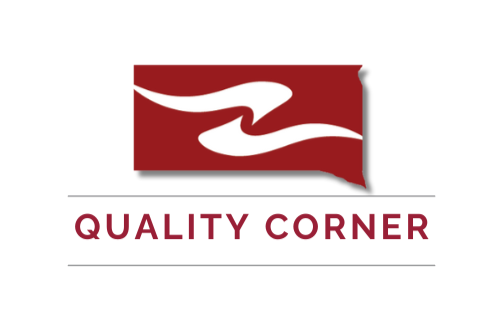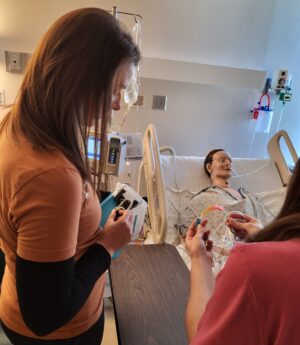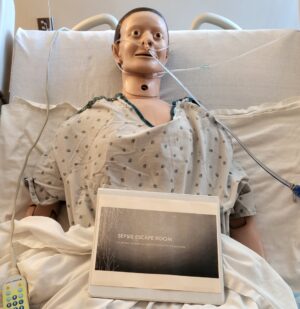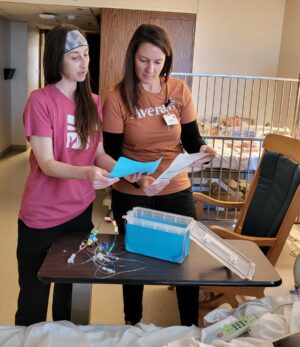According to the Association of American Medical Colleges (AAMC), sepsis was the third leading cause of death in U. S. hospitals in 2023. It affects 1.7 million people nationwide each year according to the Centers for Disease Control and Prevention (CDC), and is the most expensive condition, costing an estimated $62 billion annually in hospitalizations and skilled nursing care.
Although sepsis is treatable, diagnosis is difficult because symptoms can be similar to other conditions such as heart attack or stroke. Sepsis survival is highly dependent on the speed of treatment. According to AAMC, for every hour of delayed treatment, the risk of death increased 4-9%. Approximately 30% of patients diagnosed with severe sepsis do not survive.
SEP-1 (Severe Sepsis and Septic Shock Management Bundle) is a quality measure that establishes a treatment protocol for clinicians treating sepsis. It is a multi-step measure that focuses on timely sepsis recognition and early intervention to improve patient outcomes. The measure has been proven to improve care outcomes. A study in 2019 showed patients were 15% less likely to die than those who did not follow the protocols. A study in 2022 found that SEP-1 was associated with lower 30-day mortality and length of stay. Although the SEP-1 bundle is highly effective, hospitals struggle with SEP-1 compliance due to:
- Difficulty identifying early signs of sepsis
- Steps and timelines are hard to implement and track in a busy hospital
- Insufficient documentation/tracking tools
- Prolonged lab turnaround times
- Unavailability of clinicians to perform a reassessment
- Communication issues
- Insufficient knowledge around bundle elements
Because of the proven benefits of SEP-1, Medicare’s Value-Based Purchasing Program has added it to the Safety Domain with calendar year 2024 as the first performance year.
Avera St. Lukes Hospital in Aberdeen, South Dakota has been focusing on sepsis for over a year. Education on sepsis was provided back in 2023 and has continued. According to Melissa Waldner, Inpatient Education Coordinator, the plans of CMS to add the SEP-1 measure to the value-based purchasing program encouraged them to continue with education efforts. “Although we had seen some improvement in our compliance, our quality department wanted to be proactive in our approach and ensure we meeting quality goals going forward.”
The idea for additional effort around sepsis was presented to Avera St. Luke’s Nurse Practice Council to get support, and brainstorm ideas of how to improve compliance. The council voted to trial a “sepsis alert,” and they did so through use of a sample sepsis escape room with resources provided by SDAHO.
The education was tailored to their facility needs and launched in September 2023 to align with Sepsis Awareness Month, with the primary goal of the project to “increase sepsis bundle compliance and educate staff about the appropriate steps to take once a patient flags for sepsis and on available resources.”
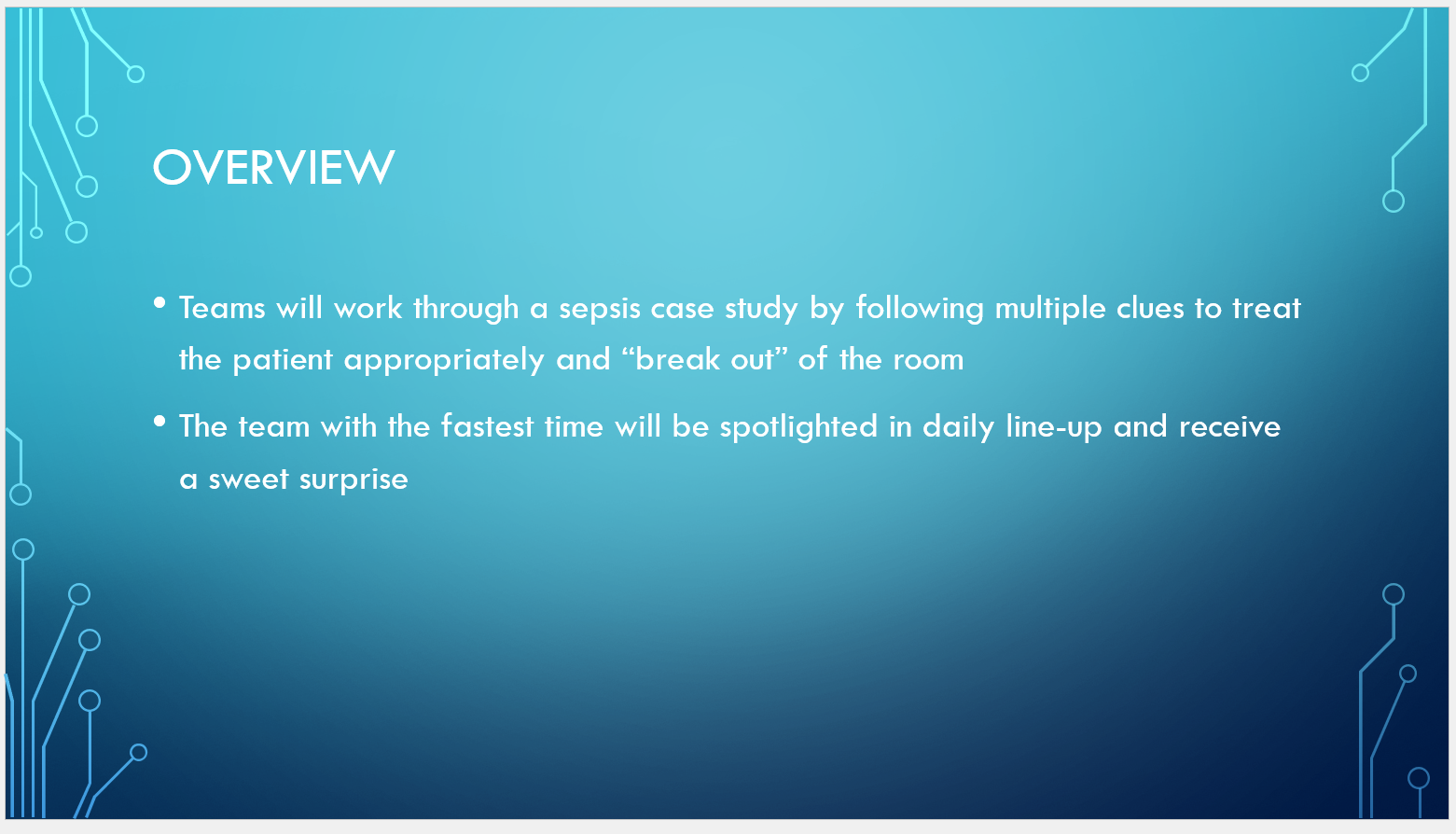 In the escape room activity, participants were divided into teams. They were presented with a patient scenario and then were given clues to help them quickly identify the patient’s condition and treat the patient appropriately, all while trying to beat the other teams’ times. This helped staff learn about diagnosis and treatment while under pressure to work as quickly as possible to save the patient’s life.
In the escape room activity, participants were divided into teams. They were presented with a patient scenario and then were given clues to help them quickly identify the patient’s condition and treat the patient appropriately, all while trying to beat the other teams’ times. This helped staff learn about diagnosis and treatment while under pressure to work as quickly as possible to save the patient’s life.
Waldner explained that buy-in from those involved was not difficult. “Buy-in from upper management was easy because having poor sepsis compliance leads to poor outcomes and negative financial implications. Upper management knew about the sepsis escape room and thought it was a unique way to provide education. Bringing the topic to our Nurse Practice Council helped create buy-in from nursing. We asked them to share barriers to sepsis compliance and we were able to identify our sepsis quality indicator tool as a huge dissatisfier amongst nursing staff,” she said.
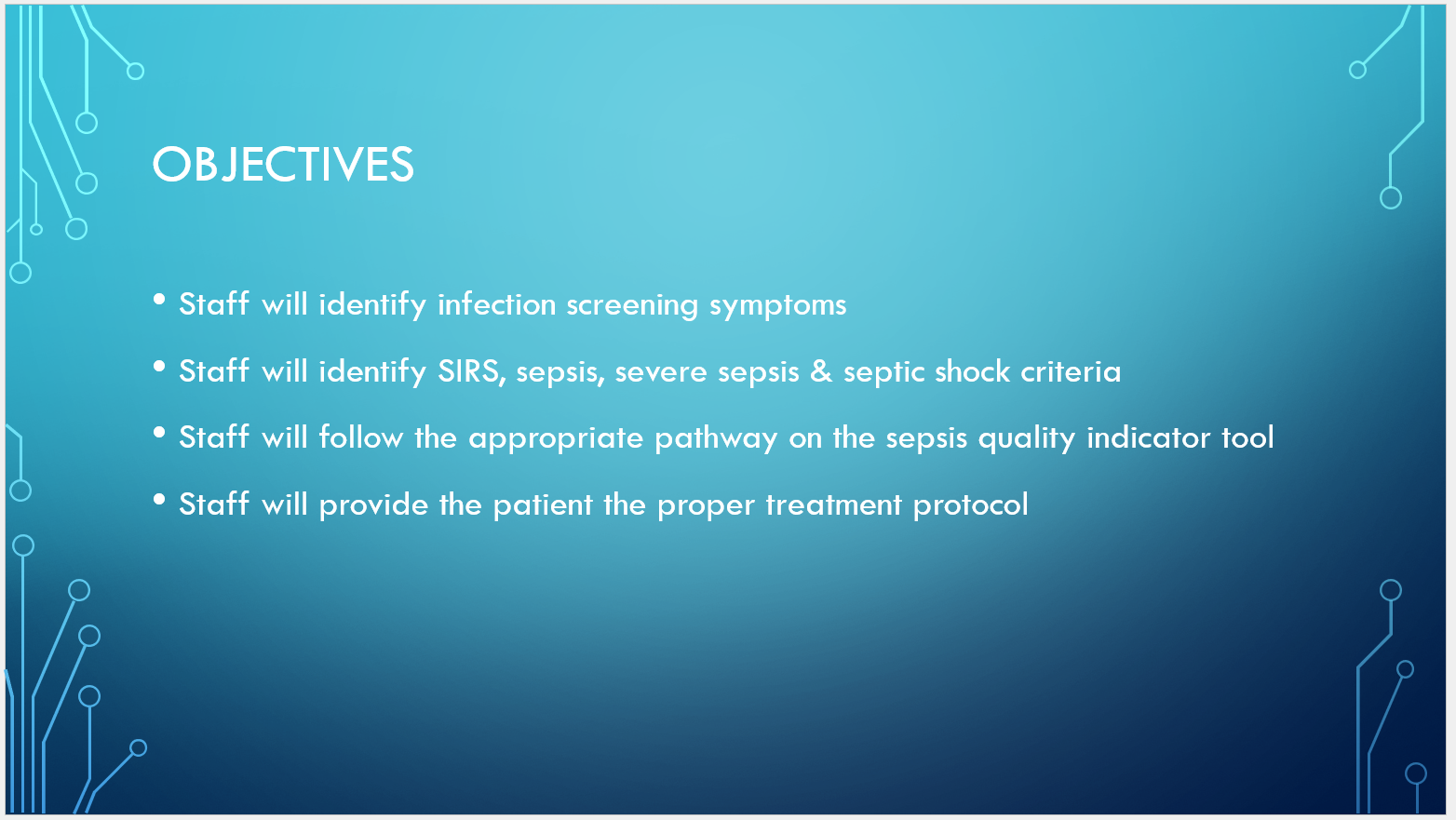 Ashley Wendler, a member of Avera St. Luke’s case management team, created a simplified algorithm and added it to the back of the quality indicator tool. Avera St Luke’s also held a few meetings with leaders from quality, ED, lab, pharmacy, MSP, ICU, etc. to discuss barriers to compliance and to vote on allowing ED staff to draw blood cultures again. Because the facility had higher contamination rates with our blood cultures in the past, lab was the only department allowed to collect them. ED thought this was a contributing factor to some of our fallouts. Lab had started using the Kurin device and it was voted to allow ED to begin collecting blood cultures again with the use of the Kurin device. Kurin provided education for ED staff prior to implementing this change. Quality and case management collaborated with other facilities through Quality Congress and specifically looked for feedback from Avera Queen of Peace in Mitchell as they had won a recent award related to sepsis,” Waldner said.
Ashley Wendler, a member of Avera St. Luke’s case management team, created a simplified algorithm and added it to the back of the quality indicator tool. Avera St Luke’s also held a few meetings with leaders from quality, ED, lab, pharmacy, MSP, ICU, etc. to discuss barriers to compliance and to vote on allowing ED staff to draw blood cultures again. Because the facility had higher contamination rates with our blood cultures in the past, lab was the only department allowed to collect them. ED thought this was a contributing factor to some of our fallouts. Lab had started using the Kurin device and it was voted to allow ED to begin collecting blood cultures again with the use of the Kurin device. Kurin provided education for ED staff prior to implementing this change. Quality and case management collaborated with other facilities through Quality Congress and specifically looked for feedback from Avera Queen of Peace in Mitchell as they had won a recent award related to sepsis,” Waldner said.
Although the escape room was a fun activity, it also presented some challenges such as the amount of prompting needed for those new to escape rooms, and providing guidelines for those who were experienced in escape rooms just looking to get the best time. Also, the combination locks used to unlock the next clues were hard for some participants.
Overall, the benefits of the escape room activity far outweighed the challenges. The activity provided team building, friendly competition, and smiles, along with the opportunity for clinical nursing students to become a part of the learning as well.
“There was not one person that did not walk away with a smile even those that entered the activity with a bad attitude,” said Walder. The following are some of the changes made as a result of the activity and continued education around sepsis:
- Bulletin board for sepsis awareness month on the med/surg floor
- Sepsis fallouts posted in various units for staff to review
- Added sepsis surveillance education to new hire onboarding
- Assigned online sepsis education modules to all staff in September to supplement the escape room
- Nursing attended the mandatory sepsis escape room in September
- 1:1 education to staff regarding steps to take when surveillance flagged for sepsis
- Sepsis fallout education format changed due to feedback from staff. Staff wanted more real time feedback and did not want to be included in the education if they were not the individual that caused the fallout
- Added a sepsis alert team to Voalte phones and added the sepsis alert to the quality indicator tool pathway
- Added the simplified algorithm to the back of the quality indicator tool for designated responsibility and roles
- Started using the Kurin device in the ED to collect blood cultures although lab had already been using
- Updated sepsis order sets for physicians
There have also been many benefits seen as a result of the efforts:
- More sepsis order sets being used
- Physicians using the fluid exemption order
- When sepsis alert has been used, the case manager was able to review the chart in real time
- Staff have been calling case management to verify the appropriate fluid orders were placed and that bundle compliance met
- Kurin device rep has been following closely and is planning to visit the ED this week for any follow up education/questions
- A review of the information and data shows improvement even with an increase in the sepsis population:
- August 58%
- September 86%
- October 90%
- November 62%
- December 77%
- January 89%
- Quality continues to track our compliance rates
They will be continuing to focus on sepsis with sepsis station to be included in their 2024 skills fair to keep the positive momentum going. The sepsis escape room was a very successful activity for Avera St. Luke’s Hospitals. “I had a lot of positive feedback that it was the most fun staff had learning. I remember one of the groups I had was yelling with excitement and cheering their team members on so loudly that the next group in the hallway could hear the enthusiasm,” Waldner said. Waldner has agreed to discuss the project further with other interested facilities. She may be contacted at: melissa.waldner@avera.org
The Sepsis Alliance is a charitable organization and lead sepsis organization in the U.S. They have offer an extensive compilation of free education and resources through their Sepsis Alliance Institute. You can find out more about their organization, mission and vision by visiting: sepsis.org
For more information on a sepsis escape room for your facility, you may also contact your SDAHO Quality Improvement Consultant:
Michelle Hofer at Michelle.Hofer@sdaho.org
Loretta Bryan at Loretta.Bryan@sdaho.org
Resources:
- Sepsis Core Elements: https://www.cdc.gov/media/releases/2023/s0824-sepsis-patients.html
- Sepsis Alliance: https://www.sepsis.org/sepsis-basics/what-is-sepsis/
- AAMC: https://www.aamc.org/news/sepsis-third-leading-cause-death-us-hospitals-quick-action-can-save-lives
- SEP-1 Bundle Study: https://www.wolterskluwer.com/en/expert-insights/delivering-care-according-to-sepsis-bundle-improves-hospitals-performance
- PubMed Study: https://pubmed.ncbi.nlm.nih.gov/34364867/
- VBP and SEP-1: https://www.wolterskluwer.com/en/expert-insights/value-based-purchasing-vbp-and-sep-1-what-you-should-know
- https://sepsisprogramoptimization.com/cms-value-based-purchasing-program
- CMS FactSheet: https://www.cms.gov/newsroom/fact-sheets/fy-2024-hospital-inpatient-prospective-payment-system-ipps-and-long-term-care-hospital-prospective-0
- https://www.wolterskluwer.com/en/expert-insights/is-the-sepsis-care-bundle-a-missed-opportunity-for-hospitals


